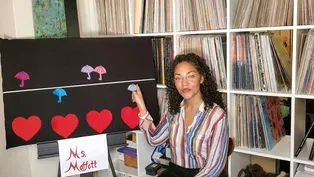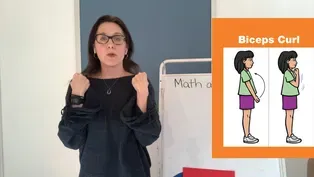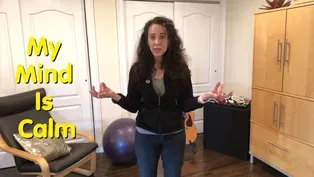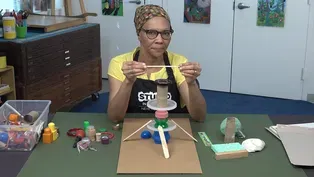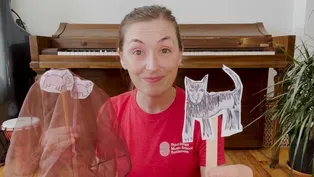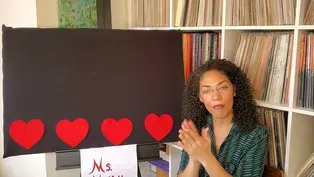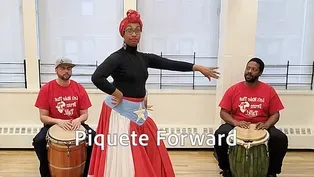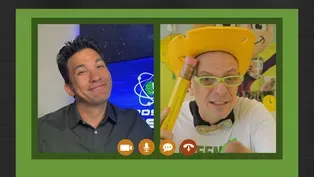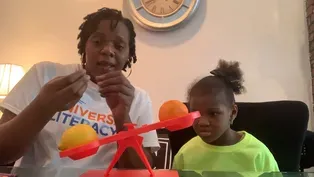
Can You Hear the Long “i” in Wide?
4/26/2021 | 58m 43sVideo has Closed Captions
Compare by length and height, read DADDY'S ARMS and THE GIRL WHO NEVER MADE MISTAKES.
Compare by length and height, read DADDY'S ARMS and THE GIRL WHO NEVER MADE MISTAKES, learn rhythms from Ghana, blend/decode oe and ie vowel teams. LET’S LEARN helps children ages 3-8 with at-home learning. One-hour programs feature instruction by educators and virtual field trips.
Problems with Closed Captions? Closed Captioning Feedback
Problems with Closed Captions? Closed Captioning Feedback
Let's Learn is a local public television program presented by THIRTEEN PBS

Can You Hear the Long “i” in Wide?
4/26/2021 | 58m 43sVideo has Closed Captions
Compare by length and height, read DADDY'S ARMS and THE GIRL WHO NEVER MADE MISTAKES, learn rhythms from Ghana, blend/decode oe and ie vowel teams. LET’S LEARN helps children ages 3-8 with at-home learning. One-hour programs feature instruction by educators and virtual field trips.
Problems with Closed Captions? Closed Captioning Feedback
How to Watch Let's Learn
Let's Learn is available to stream on pbs.org and the free PBS App, available on iPhone, Apple TV, Android TV, Android smartphones, Amazon Fire TV, Amazon Fire Tablet, Roku, Samsung Smart TV, and Vizio.
Providing Support for PBS.org
Learn Moreabout PBS online sponsorshipMore from This Collection
Video has Closed Captions
Read SCHOOL BUS and draw one, learn about prefixes and pitch, build sculptures. (57m 48s)
Running and Counting Both End in “ing”!
Video has Closed Captions
Move to improve, find the missing number, learn songs from Ghana, read ABUELITA’S SECRET. (58m 17s)
What Sound Does “aw” Make in Draw?
Video has Closed Captions
Read a story, discover "au" and "aw," learn about density, count, and move with music. (56m 58s)
Can You Find the Short “u” in Subtract?
Video has Closed Captions
Help Super Grover 2.0 solve a prickly problem, read ALL THE WAYS TO BE SMART. (56m 19s)
What Sound Does “gl” Make in Glove?
Video has Closed Captions
Play the glockenspiel, help Super Grover 2.0 make a cart move, read TWO WOOL GLOVES. (58m 9s)
Incredible Starts with Short “i”!
Video has Closed Captions
Solve problems with Super Grover 2.0, catch a rainbow, hear a piano sound like a cuckoo. (56m 9s)
What’s the Sound of “oo” in Book?
Video has Closed Captions
Explore animals’ form and function, sing about the 3 little pigs, read THE LITTLE BOX. (58m 15s)
We’re Reducing, Reusing and Recycling!
Video has Closed Captions
Learn all about rhythm and the number 9, read A BAG IN THE WIND. (56m 17s)
Video has Closed Captions
Learn to dance bomba and grow food in a city, read WOLF CUB’S SONG. (55m 20s)
How Many Syllables are in Invent?
Video has Closed Captions
Invent your own instrument, make 10 to add numbers to 20, read ONE GOLDEN RULE AT SCHOOL. (57m 36s)
Video has Closed Captions
Learn about the science behind mind reading, count shells, read MY BIG FAMILY. (57m 27s)
Which is Heavier: One Apple or Two Apples?
Video has Closed Captions
Defy gravity, learn secret code words for fast and slow in music, read WHOOO KNEW? (58m 5s)
Providing Support for PBS.org
Learn Moreabout PBS online sponsorship[upbeat music] - [Narrator] Ready to learn?
- Hi.
- Hi.
- [Narrator] It's time to share a story, read and write.
- Let's read it back.
- [Narrator] Discover science, sing.
♪ Some ♪ Play and so much more.
- Cupcake.
- Very good.
- [Narrator] Stay tuned for lessons and activities.
- We're gonna start making some words.
Isn't that fun?
[upbeat music] - [Narrator] Funding for this program was provided by The JPB Foundation.
[upbeat music] - Hello my friends.
My name is Brian Feinstein, I am a teaching artist with the New York City Children's Theater and I could not be happier than to be with all of you today.
This is gonna be a really fun adventure and guess what?
I like to write music as well.
So at the very end, I'm gonna put some music into this, but let's get started.
We've got a fantastic book today by Fabian Ferguson.
He wrote the book and he drew the pictures.
"Daddy's Arms" and this is a great adventure tale and I can't wait to take you all through it.
So what we're gonna do is we're gonna go through the book and then we'll find some musical things along the way, but I wanna stress to you, even though this story deals with a father and his son, it could be with any caregiver you want or any adult that you want, anybody at all that you feel trusted and safe with and ready to take an adventure cause that's the most fun that we could have with it.
You ready to use your imagination?
I am, okey docke, here we go.
"Daddy's Arms" by Fabian Ferguson.
I look up from my bed and what do I see?
Daddy's big, great arms reaching down for me.
Yay, my daddy's arms, my most favorite place to be.
Every second in them is an adventure for me.
I climb them like mountains, hang from them like trees, isn't that amazing?
Have you ever guys that thought of like a caregiver or an adult as like a jungle gym and you climb all over them?
That could be really, really fun too.
The best is when we swing me and make me go, weeeee!
Now, what does that feeling?
Guys, this is so amazing cause when we go on adventures and we have fun with arms and swings, it makes us feel something.
So, when you think about when you swinging on your caregivers' arms, what does that feel like?
Does it feel exciting?
Does it feel scary?
Does it feel unsure?
Does it feel like a big superhero that's gonna jump into the air?
What does it feel like to you when you think about that?
Let's continue.
A few taps at his knees for him to put down his cup, tap, tap, tap, tap, tap!
Elevator for one going up.
Looks like we've now transitioned to a car, isn't that amazing?
A car?
Who knew!
A vrooom, a honk and a couple of beeps, you better make way as we race down the streets.
Vrooom, vrooom, vrooom, vrooom, vrooom!
After all this activity on arms, might need a break, a little nap time?
Maybe.
A long nap for a break from all the laughter and fun, but when I wake up.
Oh, oh, the tickle monster.
Everyone run.
Now, I don't know about you, but what do you think about tickling?
Some people love tickling, some people go, "Oh, I don't like it, I don't like it."
Some people it almost doesn't feel so good and some people laugh out loud as if they would have it all day.
Now, isn't that interesting?
What about you?
How do you feel about tickling?
You like tickling your arms or the bottoms of your feet?
Or are you like no, no tickling for me and that's just fine too.
So let's continue.
I love this one, tossed high into space, it's a really long fall, but dad catches and tucks me like I'm a football.
Mom yells out, "Hey, that's way too high!"
But she's hard to hear as this plane flies by.
Dad's arms wet and they pinch like small crabby claws, then they dry and they warm like big fuzzy paws.
At night, I fuss cry and for good reason you see, there's only one place that is cozy for me, in my "Daddy's Arms."
The safest place I can be.
The end.
Now, you know what I love about this book as well?
Is it brings up the idea of how do we feel about hugs and our arms when we give ourselves a hug or we have our caregiver or our adult give us a hug?
It makes us feel protected, it makes us feel safe, it makes us feel loved and you know what it also does?
It can make us feel better, so if we're ever having a rough day, you know what we can do?
We can give ourselves a hug, no matter whose arms it is, it can even be yours and all of a sudden, we might feel a lot better.
How about you?
Take a second.
Everybody take their hands.
[hands clapping] Let's give ourselves a great, big hug, squeeze, squeeze, squeeze, squeeze, squeeze squeeze, squeeze, squeeze, squeeze, squeeze squeeze, squeeze, squeeze, squeeze, squeeze!
So, as promised, I am a composer as well and when I was looking through "Daddy's Arms," it just sang to me.
So, I thought what might be fun is to read you this lyric that I wrote and then I'm gonna come right back and I'm gonna play you the music to it.
Now, this is based on "Daddy's Arms" and this is the little verse I have.
"My Family's Arms" is the title.
Inside "My Family's Arms" is where I'd like to be.
Adventures and playtime are special things to me, so when I wanna play or fly or dream or dance, I jump in "My Family's Arms" every time I get the chance.
All right, let's do it one more time.
I'm gonna do two lines at a time and you read it back to me.
You ready?
Okay, here we go.
Inside "My Family's Arms" is where I'd like to be.
Inside "My Family's Arms" is where I'd like to be.
Adventures and playtime are special things to me.
Adventures and playtime are special things to me.
So when I wanna play or fly or dream or dance.
So when I wanna play or fly or dream or dance.
I jump in "My Family's Arms."
I jump in "My Family's Arms."
Every time I get the chance.
Every time I get the chance.
That's our little chorus.
Here we go.
♪ Inside "My Family's Arms" ♪ ♪ Is where I'd like to be ♪ ♪ Adventures and playtime ♪ ♪ Are special things to me ♪ ♪ So when I want to play ♪ ♪ Or fly or dream or dance ♪ ♪ I jump in "My Family's Arms" ♪ ♪ Every time I get the chance ♪ Ready?
[piano music] ♪ Inside "My Family's Arms" ♪ ♪ Is where I'd like to be ♪ ♪ Adventures and playtime ♪ ♪ Are special things to me ♪ ♪ So when I want to play ♪ ♪ Or fly or dream or dance ♪ ♪ I jump in "My Family's Arms" ♪ ♪ Every time I get the chance ♪ One last time Broad way.
[piano music] ♪ Inside "My Family's Arms" ♪ ♪ Is where I'd like to be ♪ ♪ Adventures and playtime ♪ ♪ Are special things to me ♪ ♪ So when I want to play ♪ ♪ Or fly or dream or dance ♪ ♪ I jump in "My Family's Arms" ♪ ♪ Every time I get the chance ♪ [piano music] See you next time everybody, take care and be safe.
- Hi movers and shakers.
This is Violet and I'm gonna sing one of my favorite songs, "Head, Shoulders, Knees, and Toes" and my friend Nico is going to join us and sing some in Spanish as well.
You can sing in whatever language you want.
Can you stand up straight or sit up straight and get ready to dance and move with me?
All right.
♪ Head, shoulders, knees and toes ♪ ♪ Knees and toes ♪ ♪ Head, shoulders, knees and toes, ♪ ♪ Knees and toes ♪ ♪ Eyes and ears and mouth and nose ♪ ♪ Head, shoulders, knees and toes ♪ ♪ Knees and toes ♪ [singing in foreign language] ♪ Eyes and ears and mouth and nose ♪ ♪ Head, shoulders, knees and toes ♪ ♪ Knees and toes ♪ Thanks everyone.
[upbeat music] - Hi friends, how are you today?
I'm miss Lauren and today we are going to be focusing on the long 'O' and the long 'I' sound using spelling patterns oe and ie.
We're gonna start by doing some listening games together and we're gonna be doing a lot of reading today, okay?
So you don't really need much, you're not gonna have to write anything down today.
All I would love for you to do is to be able to be a super good listener and give me your attention for the few minutes that I'm with you today, okay?
All right.
So let's get started.
All right my friends, to begin today we are going to segment sounds and words and that means we're going to break them apart, okay?
And I know, you know how to do this.
This is just a review, all right?
Let me do the first word for you, so you can know exactly what I'm asking you to do.
The word is shone.
The sounds in the word shown are 'Sh', 'O', 'N', shone.
Got it?
All right.
Now you go, the word is train.
You say.
All right, break them apart.
'T'.
Did you do it?
Yes.
Train, 'T', 'R', 'A', 'N'.
How did that go?
Good.
All right, next word goes.
Yeah.
'G', 'O', 'S'.
Wonderful.
Next word, blow.
Yeah.
'B', 'L', 'O'.
Great.
All right, how about tent?
All right.
Did you say, 'T', 'E', 'N', 'T'?
Wonderful.
All right, how about the word slice?
Yeah.
'S', 'L', 'I', 'S'.
Great job.
We're gonna continue by doing some more listening.
Another listening game.
We are concentrating on the long 'O' and long 'I' sounds, so that's what we're listening for.
I'm gonna give you a word, we're gonna repeat the word.
We're going to identify if it's long 'O' or long 'I' and then we're going to say, what place is that vowel sound?
Is it in the beginning, is it in the middle, or is it at the end?
Got it?
Okay, so I'll do the first one for you.
The word is, Oat.
Repeat.
Oat.
The vowel sound is 'O' and it's definitely in the beginning.
Do you agree?
Good.
All right, here are some words for you.
The word is time.
You say.
Yeah, is it a long 'O' or long 'I'?
Time.
Yeah, long 'I', right?
And where is it?
Is it in the beginning, the middle or the end of the word?
Yeah, it's in the middle.
'T', 'ime'.
If we stretch it, we could hear it, right?
It's in the middle.
Good job.
Okay, you ready?
The next word is boat.
Boat.
Stretch it out, 'B', 'oat'.
Is it an 'O' or 'I' sound?
Yeah, it's an 'O' and where do you hear it?
It's in the middle.
Great job.
Here's another word, ice.
You say.
Yeah, is it a long 'O' or a long 'I'?
Ice.
Definitely long 'I' and is it in the beginning, the middle or the end?
At the beginning.
Good job.
All right friends, wonderful.
Now, we're really all warmed up for our lesson today.
I want to show you these really cool looking cards.
Here we have the long 'O' sound card.
It has all the different spelling patterns of the long 'O' sound and recently you guys have been learning all about the oa and ow spelling pattern in words like know, like I know something like this, right?
K-N-O-W or in the word boat.
Right?
You have the spelling pattern of oa, yeah.
So, you've been learning about that and so today we are focusing not on these spelling patterns, we are going to focus on the oe spelling pattern.
Okay?
And that's just another way of writing down that sound of the long 'O', okay?
That's gonna be our focus for the 'O' and for the 'I'.
This is the 'I', right?
We have a picture of ice cream, yum and you have been learning and have seen before the 'I' by itself, right?
That's at the end of words and we have the i _e.
Today, we're going to be focusing right here on the ie spelling pattern.
All right, that is going to be our focus.
Let's take a look at some words that have that oe spelling pattern.
Let's go back to the long 'O' spelling card, okay?
Here's a word that you might know, let's put it down so we can take a look.
Okay, so here's a word that you might know, all right?
Let's break it down first, then we'll put it together, got it?
'T', oe, 'S'.
Toe.
Toes.
Right?
You know that word.
That's the word toes and it uses the spelling pattern oe, right?
And where is it?
In the beginning, middle or end?
Yes, it's in the middle.
Now, let's take a look at the long 'I'.
Here's the long 'I', okay?
We're going to focus on that ie spelling pattern and watch what happens.
Watch what I'm going to do to this word.
This is the word, ready?
'T', ie, 'S'.
Put it together, tie, ties.
Yeah, this is the word ties.
We went from toes, with the 'O'.
Right?
And we went to ties cause we switched out that vowel.
Nice job.
All right friends, now we're gonna do something pretty cool.
The screen is going to change and you're gonna hear my voice and I'm gonna guide you through it.
We're gonna do lots of reading.
All right, so here we go.
Do you see my laser pointer on the screen?
All right, that will help guide you as we go along throughout these slides, as you see a word, do your best to read it, okay?
I'm gonna give you a few seconds first to try it out and then I'll say it.
So that way you can check to see how you did.
Okay, here we go.
Pie.
Tie.
Die.
Toe.
Joe.
Goes.
Sharp friends, keep going.
Flies.
Skies.
Dries.
Tries.
Good job friends.
Did you notice that the I-E-S remained the same for every single one of these words?
Right?
Only thing that changed were the beginning sounds, right?
There was different blends in the beginnings of each one of these words, nice.
There're more, what would this one be?
Pies, yeah, this is the word pies.
There's not a blend, but is it?
We do have I-E-S, good job.
Last word here.
Lies, you got it.
Ready?
Toes.
Go.
Joe's.
Cried.
Tried.
Dried.
Whoa, let's read this sentence together.
You ready?
You go first.
I could eat a whole pie!
Oh, I wonder what that means, let's see.
Oh, that looks like an apple pie, have you ever had apple pie?
Yeah, there's all different types of pies, aren't there?
Huh, that could even be a pizza pie.
Which one do you like the best?
Friends, you did a wonderful job today.
Thank you so much for being here.
I hope that you learned something new about our oe and ie spelling patterns for the long 'O' and the long 'I' sounds.
If you did and you remember one of your words that you learned, make sure that you tell someone what you've learned today.
Thank you so much for being here with me.
I hope you come back, make sure you come back, so you can continue learning all about letters and sounds.
See you soon my friends.
Bye.
[upbeat music] - Hi learners, my name is Trinette.
- Hi guys, my name is Skyla.
- And thank you for joining us for today's math lesson.
Please ask a trusted adult to help you gather pencil and paper or something to write with and something to write on.
You will have 10 seconds.
Ready, set, go!
One, two, three, four.
- One, two, three, four.
- Five, six, seven, eight.
- Five, six, seven, eight.
- Nine, 10.
- Nine, 10.
Great job learners, put those materials to the side.
For today's lesson, we're going to learn how to explore height and length.
Let's start with height.
That is the distance from top to bottom.
Skyla's gonna slide over an item and so will I.
So Skyla has a red cup and I have a glass.
If we look at the two, Skyla, which one is taller?
- The glass.
- And which one is shorter?
- The cup.
- Excellent, so looking at it from top to bottom, the glass is and the cup is?
- Shorter.
- Now, let's look at a few more items that we have.
Skyla slide over your next item and I'm gonna slide over my next item, what do we have?
So we have trophies.
- Trophies.
- We've took some trophies from their sister's rooms.
So, Skyla, if we compared and looked at these trophies from top to bottom, this one's so big you guys can barely see it, which trophy is shorter?
- This one.
- And which one is taller?
- That one.
- This one, excellent.
Let's look at some other items that we have.
Skyla, what do you have next?
- A... Photo album.
- Okay, so Skyla has a green photo album and let me slide over my photo album.
Now, let's look at them from top to bottom, which photo album is taller?
- This one.
- The pink one, yes and which one is shorter?
- This one.
- The green one.
So, looking at height, we're always looking at the distance from top to bottom or bottom to top and comparing these, this one is definitely taller even if we turned it sideways, we can see that the pink album is taller than the green photo album and the green photo album is shorter than the pink one.
- But it's still same height.
- Well no, it's not the same height because this one is taller.
- What about that and that?
- Maybe has a similar pages on the inside, but if we're looking at height, this one is taller, this one is shorter.
Now, let's move on and let's talk about length.
Can you say that?
- Length.
- Length, when we're talking about length, we're looking at how long something is.
So, we have some connecting cubes here.
So there're some yellow and there's some blue, so Skyla I'm gonna give you that set, can you count how many you have there?
Don't take them apart just count them.
- One... Two, three, four, five, six, seven.
- So I'm gonna take Skyla's seven connecting cubes and I'm gonna put them here.
I'm going to take my blue connecting cubes and I'm gonna place them out on top.
So now, if we're looking at the length, which is longer, the blue or the yellow?
- The yellow.
- The yellow, definitely and which is shorter?
The blue, excellent.
Let's try another example of looking at length using connecting cubes.
So Skyla, what color do you have?
- Red.
- And I'm gonna work with blue.
So I'm gonna put my blue connecting cubes here and I have one, two, three, four, five.
Skyla, can you lie your connecting cubes on top of my blue?
- One, two, three, four.
- Okay, place them on top not lie them down cause we're looking at length not height.
Now, let's show our learners at home.
- Wow!
- Which is shorter, the red or the blue?
- This one.
- What color?
- Red.
- Red and which is longer?
- The blue.
- The blue, excellent, so when we're looking at length we're looking at how long something is.
Great job learners with this activity.
Let's move on to the next one.
Learners for height, you're measuring the distance from top to bottom.
As you can see, there's a green arrow next to a picture of Skyla which is looking at her height from the top of her head to the bottom where she has on her sneakers.
Learners, let's try this activity.
Look at the picture and I want you to tell me who is taller?
You can use the red arrow to the left of the picture to help you decide who is taller.
Would it be Laila or Skyla?
Tell me what you think.
Did you say Laila?
That is correct.
Laila is the tallest one in the picture.
Learners, let's try another example.
Now, here's a picture of Skyla with two of her sisters, who is the tallest in the picture?
Would it be Laila who's wearing the white bow, Skyla who has on the blue and black dress or Amaya who was wearing all black?
Did you say Amaya?
Yes, she is the tallest out of the three girls in the picture.
Let's try another example, who is the shortest in the picture?
Look at all of their heights and shout out loud who is the shortest?
Would it be Amaya, Skyla or Laila?
You're correct.
Skyla is the shortest girl in the picture.
Now, let's take a look at lengths.
Remember, length is when we measure how long an object is.
As you can see with this example of a carrot.
The carrot is being measured based on it's length and how long it is.
I would like you to look at the two bars and I want you to think about which bar is longer and which bar is shorter.
I'll give you a few seconds to think about it.
Okay, time's up.
Which bar is longer, the green or the brown?
Green is correct.
Which bar is shorter?
That's correct.
The brown bar is shorter.
We were able to determine that looking at the length of both the green bar and the brown bar.
Learners, here's another example.
You see that there are two clouds, cloud A and cloud B, which cloud is longer.
Did you say cloud B?
You're correct.
We have one final example.
For the last example, I want you to look at the pen and the pencil.
We're looking at the length of each, can you tell me which is longer?
You're correct.
The pen, which is green and blue is longer, which makes the pencil shorter.
Great job students with looking at height and length Learners, you can practice the concepts of height and length at home with a trusted adult.
For example, you can ask a trusted adult or a family member to stand next to just like Skyla's standing next to me and ask these questions, who's tall?
Skyla, you or I?
- You.
- Whose shorter learners?
- Me.
- Skyla and that's compared height or let's say you wanted to practice looking at length.
You can take something again, asking a trusted adult such as a spoon.
Skyla, can you hold your spoon up so the learners can see and I'm gonna hold my spoon, nope, we gonna measure the length, not height.
So, if we did this, this way, who has the shorter spoon?
- Me.
- Skyla, who has the longer spoon?
- You.
- I do.
Learners, thank you so much for joining us.
Until we meet again, bye-byes for now.
- Bye, see you soon.
- See you soon.
[upbeat music] [singing in foreign language] ♪ Oh, oh, oh, oh, oh ♪ ♪ Oh, oh, oh, oh, oh ♪ ♪ I say, oh, oh, oh, oh, oh ♪ [singing in foreign language] - Greetings to you all.
Hi, my name is Amos from a country called Ghana in West Africa.
I teach music at Third Street Music School.
Today, we are going to learn a song called "Nyonchele."
Please repeat after me, everybody say, "Nyonchele."
"Nyonchele."
One more time, "Nyonchele."
"Nyonchele."
"Nyonchele" means the moon.
The moon.
We perform this song whenever we see the moon or whenever we see the stars and it's very fun song.
So, I will teach you a song that we sing before we play our rhythm on the drum.
I'm using a drum called tupelo.
This tupelo drum has a design, a traditional Ghanaian design and it has a perfect sound that I want to use that is why I'm about to use this drum.
If you don't have a drum, you can practice on your lap or on a table or on a big plastic ball.
Okay?
And I have a special shaker here that I will play and this shaker keeps the beat because we sing, we will sing in that beat, the heard beat.
Okay?
And this is the song.
Everybody I will sing the song, then I would love you to repeat after me.
The song is.
[singing in foreign language] And it simply means.
♪ The moonlight is out, we will play and dance ♪ ♪ The moonlight is out, we will play and dance ♪ And this is a song performed by the Ghana people, okay?
"Nyonchele."
So, please repeat after me.
Everybody say, "Nyonchele."
"Nyonchele."
One more time, "Nyonchele."
"Nyonchele," wow!
You sound good, you're singing in one of my local language.
One more time, everybody, please say.
[speaking in foreign language] Wow, one more time.
[speaking in foreign language] Now let's try the third part.
[speaking in foreign language] Means the moonlight is out.
[speaking in foreign language] Means we will play and dance.
So now, let's try together, everybody sing after me, okay?
[singing in foreign language] Now, let's combine it together after counting of three, let's all sing it together.
[singing in foreign language] Let's try.
One, two, three, we sing.
[singing in foreign language] Wow!
Now, can we try it?
Let's repeat it two times, okay?
After counting of three, one, two, three, we sing.
[singing in foreign language] Again.
[singing in foreign language] Wow!
You know what?
Now, you can tap your lap and sing at the same time and I have this special shaker that I will play to support you, okay?
We are repeating the song four times.
How many times?
Four times.
So, ready?
After counting off three we'll start singing.
One, two, three, we sing.
[singing in foreign language] Three more.
[singing in foreign language] Two more.
[singing in foreign language] Last one.
[singing in foreign language] Wow, now we can translate what we just sing into English language and this is the English version ♪ The moonlight is out, we will play and dance ♪ ♪ The moonlight is out, we will play and dance ♪ Thank you, thank you.
Now, it's time to play the drums.
Now, we have the chore and break and this is the chore, I'm about to play the chore.
Please sing the chore after me, everybody say, pa, pa, pa, pa, pa, pa, pa, pa, pa!
Pa, pa, pa, pa, pa, pa, pa, pa, pa!
Now, that is the chore, sing the break after me, ♪ Bo, piti, piti, bo, piti, piti, bo, piti, piti ♪ ♪ Boom, boom, boom ♪ ♪ Bo, piti, piti, bo, piti, piti, bo, piti, piti ♪ ♪ Bo, piti, piti, boom, boom, boom ♪ Now, let's try that basic rhythm.
Everybody say, piti, boom, boom, boom!
Piti, boom, boom, boom!
Thank you, now repeat the chore after me on your drum, okay?
♪ Pa, pa, pa, pa, pa, pa, pa, pa, pa ♪ ♪ Pa, pa, pa, pa, pa, pa, pa, pa, pa ♪ Now let's try the break.
♪ Bo, piti, piti, bo, piti, piti, boom, boom, boom ♪ ♪ Bo, piti, piti, bo, piti, piti, boom, boom, boom ♪ Okay, now let's try the basic rhythm.
♪ Piti, boom, boom, boom ♪ ♪ Piti, boom, boom, boom ♪ Now let's combine it all together, everybody okay?
One, two, three, go!
♪ Pa, pa, pa, pa, pa, pa, pa, pa, pa ♪ Break.
♪ Bo, piti, piti, bo, piti, piti, boom, boom, boom ♪ ♪ Bo, piti, piti, bo, piti, piti, boom, boom, boom ♪ Now the basic rhythm.
♪ Piti, boom, boom, boom ♪ So I want you to join me, let's all play the basic rhythm.
♪ Boom, boom, boom, piti, boom, boom, boom ♪ Keep going, okay?
Do not stop, I will play the the frame beat to support you.
♪ Piti, boom, boom, boom, piti ♪ While you're playing this what I'm singing.
♪ Piti, boom, boom, boom, piti, boom, boom, boom ♪ ♪ Piti, boom, boom, boom, piti, boom, boom, boom ♪ ♪ Piti, boom, boom, boom, piti, boom, boom, boom ♪ ♪ Piti, boom, boom, boom ♪ Keep going, you're doing good.
♪ Piti, boom, boom, boom, piti, boom, boom, boom ♪ ♪ Piti, boom, boom, boom, piti, boom, boom, boom ♪ ♪ Piti, boom, boom, boom, piti, boom, boom, boom ♪ ♪ Piti, ♪ ♪ Piti ♪ We're about to end.
We play that chore then we end with the break.
♪ One, two ♪ ♪ One, two, three ♪ We end.
♪ Pa, pa, pa, pa, pa, pa, pa, pa, pa ♪ Then break.
♪ Bo, piti, piti, bo, piti, piti, bo, piti, piti ♪ ♪ Bam, bam, bam ♪ So we did repeat that break, the break was three, right?
It's, one.
Two.
Three.
Then, one, two, three.
So it's three, three, but when you combine it's six, okay?
Now, everybody keep playing that beat, okay?
♪ Piti, boom, boom, boom ♪ Keep going after counting of four, ready?
One and two and three and four.
♪ Piti, boom, boom, boom, piti, boom, boom, boom ♪ ♪ Piti, boom, boom, boom ♪ If you can sing the song, let's sing the song together.
[speaking in foreign language] At the same time.
One and two.
One and two and three we sing.
[singing in foreign language] Everybody.
[singing in foreign language] Ready to stop?
One, two, three, four, stop!
Yay!
Wow, you sang very, very, very beautiful, okay?
So we have learn.
[speaking in foreign language] Mean the moonlight is out.
[speaking in foreign language] It means we'll play and dance.
[singing in foreign language] ♪ The moonlight is out ♪ ♪ We will play and dance ♪ ♪ The moonlight is out ♪ ♪ We will play and dance ♪ Thank you, thank you.
Now, we are about to wrap up.
So, I'm about to sing the wrap up song and this song mean weather.
Okay, is "Ayiko" and is one of the local Ghanaian language, the Ewe language and this is the song.
[singing in foreign language] Thank you.
[upbeat music] - Hi friends, my name is Morgan and I'm really excited to share one of my favorite books with you.
Today we're gonna read a book called, "The Girl Who Never Made Mistakes."
What you think the book is about?
Yeah, let's look at the cover.
So here we have our main character and she's really good at juggling.
Juggling is when you throw different objects in the air and you keep catching them.
So you can see that all her objects keep going around and around and she's smiling.
It looks like it's going pretty well.
So in our book today, our main character never makes mistakes until one day she gets worried that she might make a mistake.
Do you know what worried means?
Worrying is a not so good feeling, it feels kind of like when we're scared or upset about something that we think might happen.
So, let's read and see what happens when our character feels worried and what she does when she feels that way.
"The Girl Who Never Made Mistakes" by Mark Pett and Gary Rubinstein.
Illustrated by Mark Pett.
For Beatrice Bottomwell, Friday began like any other day.
She matched her socks and of course she put her shoes on their proper feet.
She remembered to feed her hamster Humbert his favorite food broccoli and when she made a sandwich for her brother Carl's lunch, she used exactly the same amount of peanut butter as jelly.
When she stepped outside to greet her fans, she didn't forget to say, "Good morning and thank you."
They asked if she made her bed, she had.
They asked if she forgot to do her math homework.
Nope, "What about tonight's talent show?"
They asked.
"I'm ready," said Beatrice with a smile.
After all her juggling act had won three years in a row.
She must be really good at juggling, she won three years in a row.
Most people in town didn't even know Beatrice's name.
They just called her the girl who never makes mistakes because for as long as anyone could remember, she never did.
Unlike Beatrice, Carl made lots of mistakes.
He ate his crayons and drew with green beans.
He danced with his hands and played the piano with his feet.
Carl loved to make mistakes.
At school, Beatrice was on a cooking team with her two best friends Millie and Sarah.
To make their giant rhubarb muffins, they needed four eggs.
Beatrice went to the refrigerator and carefully chose the biggest, eggiest, eggs she could find.
Wow, look at this page.
I wonder what's gonna happen.
Let's see.
But on the way back, her leg slipped out from under her, the eggs went flying.
Beatrice was about to make her first mistake.
How do you think she feels if she's gonna make her first mistake?
But she didn't.
Oh, that was close by Beatrice.
Look, she caught the eggs, she caught one on her foot, two in her hands and one in her mouth.
"Sorry, Beatrice I dropped a piece of rhubarb," said her friend Millie and Beatrice was answering with the egg in her mouth and says, "Oh, Antoinette, Elly."
For the rest of the school day, Beatrice could not stop thinking about her almost mistake.
Wow, so we can see the rest of her school day, she wasn't as happy anymore.
I wonder what she's feeling?
On her way home from school, Beatrice watched Millie and Sarah ice skating in the park.
"Come join us," said Millie.
"It's fun," said Sarah.
Beatrice watched them slip and slide on the frozen pond.
Millie and Sarah will have to say wobbled on the ice.
"No, thanks," said Beatrice.
At supper, Beatrice barely touched her food.
"Is everything all right kiddo?
Asked her father.
"I'm worried I'll mess up tonight," said Beatrice and everyone will be watching.
"Worry?
"You don't make mistakes," he said with a smile.
Beatrice tried to smile too.
So here Beatrice is telling us that she's worried and she doesn't look very happy and her body is hunched over.
Have you ever felt worried before?
Me too.
It's a not so good feeling.
Let's see what Beatrice does with her worry.
After supper, Beatrice got ready for the talent show.
First she woke Humbert up from his nap.
Next, she got the salt shaker from the kitchen table.
Finally, she filled the balloon with water.
The school auditorium was packed.
Beatrice felt her stomach jumping around inside her.
Beatrice waited for her juggling music to begin.
"That's her, that's the girl who never makes mistakes," said a woman.
"Oh, we know she'll be perfect," said a man.
When the music started, she tossed Humbert into the air.
Next, she added the salt shaker and finally the water go in.
How do you think her juggling act is gonna go?
Let's see.
Beatrice didn't miss a beat.
The crowd clapped with delight, but Beatrice noticed something odd about the salt shaker.
The specks falling out of it were not white.
Oh, oh, what do you think the specks were?
Aahhchooo!
Humbert was so surprised by his sneeze that he grabbed the water balloon with his claws Kablooie!
Humbert, pierces the water balloon and the pepper rained down on top of Beatrice.
For the first time in as long as anyone could remember, Beatrice made a mistake and it was a big one.
So she grabbed the pepper instead of the salt.
The music stopped, Beatrice didn't know what to do.
Cry, run off the stage?
The crowd sat stunned, they couldn't believe that the girl who never makes mistakes, made a mistake.
Beatrice looked up at Humbert.
He looked back at her.
His hamster food was soaked and speckled with bits of balloon.
Beatrice let out a giggle.
The giggle grew into a chuckle and the chuckle who became a laugh.
The people in the crowd looked at each other and then back at Beatrice.
They began to giggle, then chuckle, then finally roar with laughter.
Beatrice and the the audience laughed until they couldn't remember why they were laughing.
That night Beatrice slept better than she ever had.
Why do you think Beatrice slept better than she ever had?
Yeah and she realized that she could make a mistake and it's okay.
In the morning, no fans greeted Beatrice.
When she got dressed, Beatrice for no reason at all put a polka dot sock on one foot and a plain sock on the other.
Beatrice and Carl made sandwiches.
This time they put peanut butter and jelly on the outside.
They called it a bit of inside out PB and J.
Lunch was messy and delicious.
Later, Beatrice found Millie and Sarah skating in the park.
They fell a lot and laughed.
Now, people no longer call her the girl who never makes mistakes, they just call her Beatrice.
Wow, I'm so glad that Beatrice learned that it's okay to make mistakes and now everyone knows her name is Beatrice and she can make a mistake because that's okay, everyone makes mistakes.
Did you notice how worried Beatrice was about making a mistake?
Have you ever felt worried before?
What does your body feel like when you're worried?
Yeah, we might get a stomach ache or our body might tense up kind of like Beatrice when she was telling her dad that she was worried.
We can see that her body is hunched over and she's not smiling and Beatrice was worried all day after she almost dropped the eggs.
It seems like she was holding onto that worry because she was worried after school at the park and she was worried at dinner and right before the talent show and when we hold onto our worries like that, we get stuck in our worry and when we're stuck with our worries, it makes us feel not so good.
So, I was thinking today, maybe we could come up with some ideas to help Beatrice let go of those worries and not be stuck in her worries all day.
You think you could help me brainstorm or we can work together and think of ideas.
Great.
So let's think, what is one thing that Beatrice did in the story to help her feel not so worried?
Great, she told her dad how she was feeling.
So one thing that she could do and she did is talk to a trusted adult or a friend.
Who is someone that you could talk to when you feel worried?
Great.
Let's think what's another idea.
Yeah, after everything fell at the talent show, Beatrice laughed and realized that it was a silly thing and she realized that it wasn't such a big mistake and it could be fixed.
So, maybe when we feel worried about something, we can think about it and see how we can fix that worry, that might help us let go of that worry and not be so stuck.
What's one more idea?
What's something that can calm our bodies when we feel worried?
Yeah, we can do some deep belly breaths.
Oh, I have two really fun deep belly breaths that we can practice.
You wanna practice with me?
Great.
Okay, so our first belly breath is a balloon belly breath and we're gonna have a really big balloon and we're gonna deflate it or let all the air out and then we're going to blow it back up.
Are you ready?
So, we're gonna hold a big balloon first and we're gonna breath in with our nose, really big breath in and when we breathe in, we're gonna deflate the balloon and then when we let our breath out, we're gonna inflate the balloon and blow it back up, okay?
So, we're gonna squeeze all the air out and breathe in.
And we're gonna blow the balloon back up and breathe out.
[Morgan exhaling] Wow, great job.
Let's try again.
Let's breathe in and push all the air out and blow.
[Morgan exhaling] The balloon back up.
Great job, all right, let's try one more.
Push all the air out and breathe in and blow the balloon back up.
[Morgan exhaling] Wow, those are really big balloons.
Okay, let's let the balloon go.
Wow!
I can see it flying really high cause that was a lot of air.
You see yours?
Wow!
Great job.
Okay, our second big belly breath is we're gonna pick a flower and we're gonna blow the petals.
So we're gonna pick a pretend flower.
So pick your pretend flower.
What color is yours?
That sounds beautiful, mine's pink and we're gonna breathe in and smell the flower and then we're gonna breathe out and blow the petals, okay?
So get your flower ready and breathe in and then blow the petals out.
[Morgan exhaling] Let's try it again and when we blow the petals out, we can see how far they go, the longer we blow out, ready?
Okay, let's try it again, ready?
Breathe in.
Smell the flower and blow the petals out.
[Morgan exhaling] Great job and one more time.
Breathe in and smell the flower and blow the petals out.
[Morgan exhaling] Wow!
Can you see how far those petals went?
They went really far and lots of beautiful colors altogether.
Great job friends.
So, we just thought of some really great ways that Beatrice could feel less worried, even how we could feel less worried.
So, we can talk to a trusted adult or a friend.
We can think about that worry and see how we can fix it and we can take some deep belly breaths to calm our bodies.
Hopefully you can share some of these ideas with your trusted adult and you can teach them these new belly breath also.
Thanks for joining me today friends.
Bye.
[upbeat music] - [Narrator] Funding for this program was provided by The JPB Foundation.
[upbeat music] [dramatic music]
Let's Learn is a local public television program presented by THIRTEEN PBS
